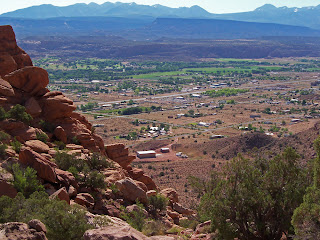I rode out along the Colorado River before sunup under a dark and rumbling sky. Kane Creek Road winds peacefully along the slow-moving river, and I figured I’d see more on the way back. I locked the bike to a post where the sign reads, “The Moab Rim Route follows a sandstone ledge to the rim above Moab, gaining 1,000 feet in about a mile. Rated 4+ by the Red Rock Four-Wheelers Jeep Club. Standard jeeps cannot make it.” I figured I could go where standard jeeps can’t.
Clouds moved fast overhead as I climbed the sandstone bench that angles steeply up from the river. White marks painted on the rock guide jeep drivers, which I was happy not to be. I have never seen a road so steep and don’t see how any jeep, no matter how modified, could make it. See how the rocks have been scratched and chipped by jeep parts as they climbed upward in the right picture. Just follow the white marks, folks, and obey all traffic laws.
Soon the cloud that had been muttering from beyond the ridge came into full black view and fired a warning shot. I looked for cover and found it under a rock overhang with about three feet of head clearance where I could cower some four feet into the wall. There I stayed dry while rain began, not slowly, but in a deafening blast of huge drops and hail. I snapped these pictures of the splashing drops from inside my lair.
It was over in fifteen minutes, and I went out into a new world, where dry had been transformed into wet. I heard a roar as of a nearby waterfall. I looked up at what had been a dry sandstone cliff, now plashing with a streaming waterfall pouring over its top. And beside me, where dry rock had been, a creek flowed. The sound of it was not loud like the storm, but peaceful as a mountain meadow.
I watched the waterfall and the creek for some time, perhaps fifteen minutes, until they stopped flowing. Here is the place where the waterfall was.
As the storm moved away, sun played on its clouds, painting their edges with silver and their undersides in burnt ochre. I felt like I had been transported to another world and returned safely to earth.
As I walked back down the jeep trail, the Colorado River brightened into its midday normality. The storm had dispersed into a few thin clouds, and mud covered some of the smooth rocks, making the descent difficult even for a non-jeep.

























































